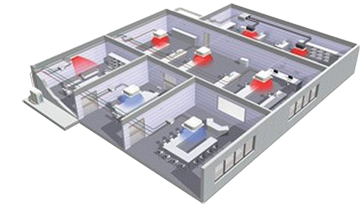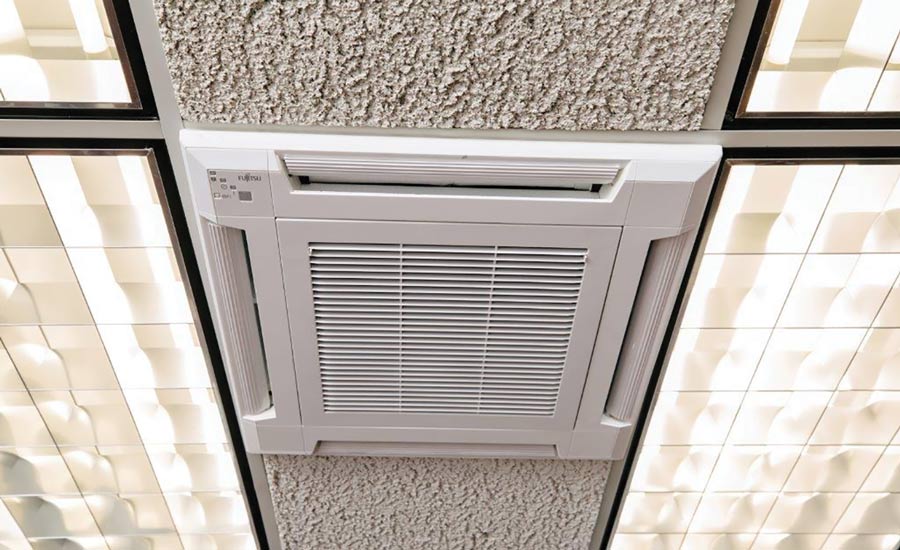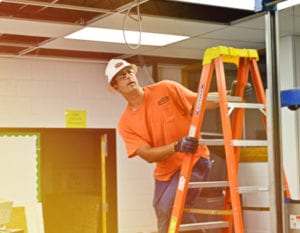Whether you’re the facility maintenance manager or an up-and-coming maintenance technician, you know how important it is to run an efficient facility. You also know that heating and cooling account for the most significant expenses at any commercial facility. What if we told you that you could improve efficiency in your HVAC system while also reducing the expenses that come with it? With a VRF HVAC system, you can do just that.
WHAT IS A VRF HVAC SYSTEM?
Like most other systems, Variable Refrigerant Flow (VRF) HVAC units consist of an outside unit and inside fans. The difference, however, is that a VRF HVAC system does not use ducting like traditional systems. Instead, it uses refrigerant lines to cool or heat air throughout a series of small air handlers located throughout the facility. This allows for each handler to control the amount of hot or cold air entering a space.
VRF systems can produce 30% to 40% energy savings. Which is significant when you consider 50% of a building’s energy usage can come from its HVAC system. VRF systems are essentially a ductless system that distributes refrigerant to different zones through refrigerant piping.
VRF System Operation


VRF system showing heating and cooling in different zones.
Commonly known as mini split, VRF systems are unique in their ability to vary and control the refrigerant flow through multiple evaporator coils. This allows them to provide individual temperature control in various mechanical comfort zones. Each zone will have its own thermostat that adjusts independently of other zones in the system.
VRF systems use direct expansion (DX) throughout the system as part of the basic refrigeration cycle. This allows them to transfer the heat from the room directly to evaporator coils located within the space that’s being conditioned. The heat-transfer carrier, the refrigerant in this case, delivers heating and cooling to various zones with less energy loss.
Each VRF system acts as a multi-split system – connecting multiple indoor units with one centralized outdoor condensing unit assembly. This allows them to provide simultaneous heating and cooling and heat recovery in various zones.
The advantages of a Variable Refrigerant Flow HVAC system include:
- Increased energy efficiency and energy savings. This can average about 20-30% energy savings relative to variable air volume systems with reheat and constant air volume systems with gas heat.
- Develops efficient part-load performance due to inverter-duty variable-speed compressors modulating the capacity from 10-100%.
- Holds efficient zoning control from simultaneous cooling and heating with heat recovery.
- Reduces ductwork and duct losses that can be confined to the ventilation air system (approximately 20% of the conventional HVAC system).
A modern VRF system can provide technicians some major advantages. These include: zoning, individual temperature control, minimized ductwork, excluding the need for secondary fluids (chilled-water or hot-water distribution), and associated costs.
Many VRF systems will require an R-410A refrigerant for the heat-transfer fluid and the working fluid. This allows the system to achieve a high energy-efficiency ratio (EER) of 15 to 20, while developing an integrated energy-efficiency ratio (IEER) of 17 to 25. VRFs are 20-30% more efficient than conventional HVAC systems due to its ability to utilize a partial load operation, speed modulation, zoning capabilities, and heat-recovery technology.
From the benefits above, you’ve probably gathered that a VRF HVAC system is incredibly efficient. These units lead to an increase in overall facility efficiencies and cost reduction.
VRF HVAC System: FAQ


VRF Air Handler
Q: How does it provide simultaneous heating and cooling?
A: VRF can simultaneously heat and cool a building by absorbing residual heat when cooling one zone and redirecting it to another zone. This results in less energy waste and more productivity.
Q: Can a VRF only be used in commercial buildings?
A: No, it can be used in both residential and commercial. VRF systems can be scaled to meet the climate control needs of a small single-family residence all the way to commercial, high-rise buildings.
Q: Are VRF systems difficult to install?
A: Not at all! VRF equipment weighs much less than ducted equipment which happens to make it easier to install, especially for those with limited space.
Q: What are the 3 ways a VRF system works?
A: 1. The VRF heat pump system can provide heating and cooling for all indoor units during a specific time. 2. The VRF system can provide cooling and heating which doesn’t occur at the same time. 3. VRF heat-recovery systems provide simultaneous cooling and heating as well as heat recovery. This results in transferred energy from cooling zones to heating zones of the building.
READY TO MAKE THE SWITCH?


Many large companies are making the switch to sustainable practices. Commercial facilities are no exception. The efficiency of a VRF HVAC system adds value in many sustainable programs and certifications, such as LEED®.
Whether you’re designing a new facility or changing out an existing unit, a VRF system is a great way to save space. These units often don’t require air ducts to deliver air throughout the facility. Evaporators are also installed within the ceiling or can be wall-mounted.
A noteworthy feature of a VRF HVAC system is the ability to control the temperature of each area. Rooms with outside facing walls may need more warm air during the winter. They also may need more cool air during the summer than those in the center of the building. By controlling how much heat or warmth is distributed by each handler, you can ensure that all occupants are comfortable.
[Need help reduce stress and energy consumption on your HVAC? Read: Climate Control Strategies to Reduce HVAC Stress.]
Is VRF the RIGHT solution for your building? If you check off any of these… It’s time to make the switch:
- Your building requires some areas to be colder while others to be warmer
- Your building has or needs quick temperature changes
- You need a low-cost HVAC solution
- Ductwork is not an option for your building
With a typical central HVAC system, you lose all forms for heating or cooling when you need to work on the unit. During the blazing hot summer or the frigid winter months, this can be a problem. A single degree drop in the winter or rise in the summer can drastically decrease occupant comfort.
Since a Variable Refrigerant Flow HVAC system contains a series of air handlers, technicians can work on one handler at a time. This allows other units in the facility to remain operational. The reduction in downtime is both comfortable and cost-efficient.
The following features can be used when installing VRF-enhanced technology:
- Variable-speed and capacity-modulated inverter duty compressors
- Outdoor fans with variable frequency drive motors
- Indoor units with electronically commutated motors (ECM).
STAY COMPLIANT WITH CODES AND STANDARDS
If you’re thinking about renovating your VRF system, it’s essential that you’re implementing the most current codes and standards. All VRF systems must comply with ASHRAE Standard 15 (packaged with Standard 34): Safety Standard for Refrigeration Systems and Designation and Classification of Refrigerants. This adheres to refrigerant capacities and possible leakage for systems that serve small rooms, and could cause oxygen depletion.
Earlier, we mentioned that all VRF systems use the refrigerant R-410A. The safety classification of R-410A in ASHRAE Standard 34 is classified in group A1: nontoxic and nonflammable refrigerant with zero ozone-depletion potential. Due to the ability of oxygen depletion ASHRAE has established the maximum refrigerant concentration limit (RCL). The RCL is 26 lbs/1,000 ft3 of room volume for occupied spaces.
According to Standard 15, a VRF system is classified as A direct system/high-probability system. This is because a refrigerant leak can potentially enter into the occupied space.
Apply ASHRAE Standard 15 requirements to all VRF systems using the following steps:
- Determine the occupancy classification for the rooms
- Calculate room volume
- Determine the amount of refrigerant in the system including the outdoor unit, indoor units, and associated piping
- Verify that the room is not too small using the following formula:
Minimum allowed floor area (sq ft) = Total system refrigerant charge (lbs) x 1,000 RCL (lbs/1,000 ft3) x ceiling height (ft)
Need VRF HVAC System Advice?
Establish a plan for long-term equipment success with Rasmussen Mechanical Services today! Call us at 1-800-237-3141, email sales@rasmech.com, chat with a support agent, or contact us online.
You can also reach out to one of our offices in Omaha, Council Bluffs, Denver, Sioux City, Sturgis, Gibbon or Lincoln.




